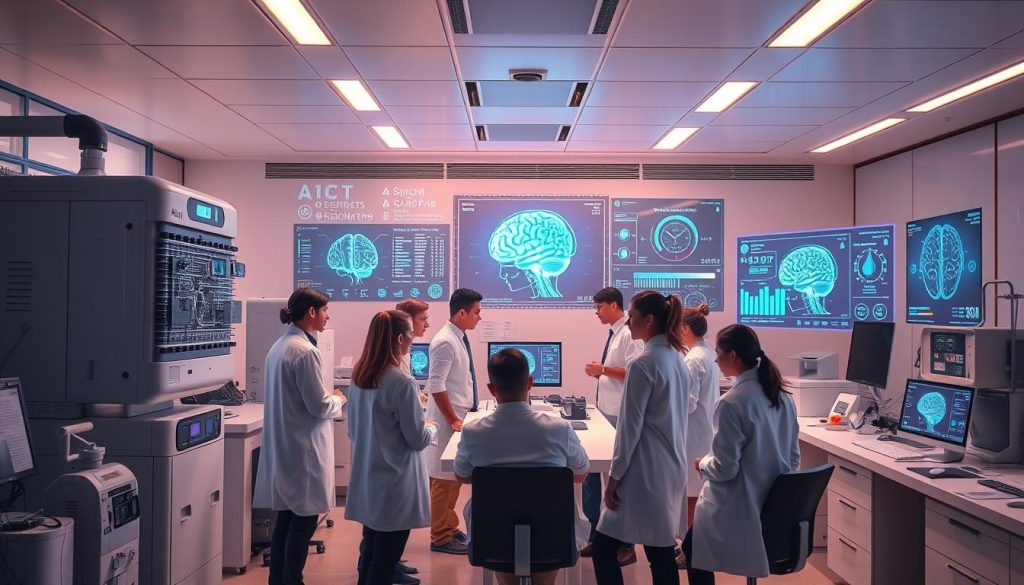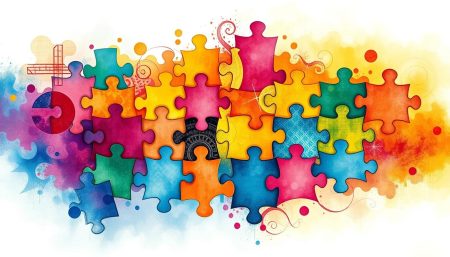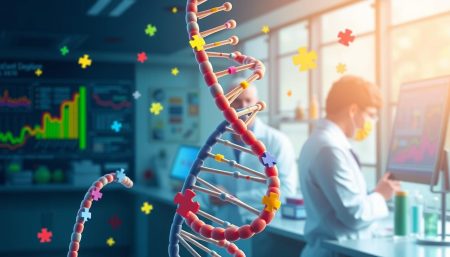Autism Spectrum Disorder (ASD) brings both challenges and benefits to those who experience it. Knowing how is autism spectrum disorder diagnosed is key to getting the right support and growth. This guide helps us understand the detailed steps needed for a fair and caring diagnosis.
By looking into autism assessment methods, we gain more insight. This leads to better timing and tailored help for those with ASD.
Exploring autism diagnosis shows its deep impact. Accurate tests and support start with the first diagnosis. This guide will cover the main points of identifying ASD, helping families and doctors find the right help for individuals.
Let’s dive into the world of diagnosing autism. It’s a journey filled with the chance for support and understanding.
Understanding Autism Spectrum Disorder (ASD)
Autism Spectrum Disorder is a complex condition that affects how people interact, communicate, and behave. It’s important to understand this disorder well. This knowledge helps doctors identify it and also supports the community in helping those with autism.
What Is ASD?
Autism spectrum disorder is a group of conditions that affect social skills, behavior, and communication. It’s key to know the early signs of autism in children. This knowledge helps in early support and intervention.
The Spectrum Nature of ASD
The term ‘spectrum’ in autism spectrum disorder means there’s a wide range of symptoms and abilities. Each person with ASD is unique, needing a personalized approach in therapy and education.
From milder challenges to more severe impairments, people with ASD need different levels of support. The early signs of autism in children can vary a lot. This shows how diverse the disorder is.
The Importance of Early Diagnosis of Autism
Managing autism spectrum disorder (ASD) starts with early diagnosis of autism. Finding autism symptoms early helps a lot. It makes therapy more effective, improving thinking, social, and emotional skills. This is key because kids’ brains are most open to change in their early years.
Using autism diagnosis tools in regular check-ups is important. Autism is complex, so these tools need to be both advanced and gentle. They must spot the different ways autism shows up in kids.
- Screening procedures that are integrated into regular health checks
- Diagnostic assessments that take into account detailed developmental histories and behavioral analysis
- Continuous monitoring and evaluation to refine diagnoses
Healthcare providers must keep learning about new ways to diagnose autism. They should use the latest autism diagnosis tools. These tools give insights for a therapy plan that fits each child’s needs.
The good news about early diagnosis of autism is huge. It helps kids grow and succeed in school and socially. It also helps families and caregivers find the right support for their child.
Initial Observations: Spotting Early Signs of Autism in Children
Spotting early signs of autism in kids is key for early help. This part talks about important signs that show autism might be present. It helps start the process of checking and finding out if a child has autism.
Typical Age for Early Symptoms to Appear
Autism signs often show up before a child is three years old. Parents and doctors usually see these signs in the first two years. Watching closely during this time is important for catching autism early.
Key Behavioral Indicators in Young Children
Here are some important signs that might mean a child needs to be checked for autism:
- Limited eye contact or trouble keeping eye contact
- Speech that’s late or no babbling by one year old
- No gesturing, like pointing or waving, by one year old
- Doing the same thing over and over, like flipping things or repeating words
- Being very upset or scared by changes in routine or place
- Being very focused on certain things or objects
- Having trouble with social interactions, like sharing or showing feelings
Parents and regular doctor visits are very important. They help find these signs early. This means kids can get help sooner, which can really help their development.
How Is Autism Spectrum Disorder Diagnosed?
Diagnosing Autism Spectrum Disorder (ASD) is a detailed process. It uses many autism evaluation methods and tools. Experts focus on a flexible yet structured approach. This helps identify ASD accurately, meeting each person’s needs and following standard criteria.
The autism evaluation procedure starts with a detailed developmental history. Then, it involves observing the person’s behavior. These steps are key to guiding further assessments to confirm the diagnosis.
Different autism diagnosis tools are used to get a full picture of a person’s abilities and challenges. These include standardized tests, parent interviews, and direct behavioral assessments.
| Tool Type | Description | Usage Context |
|---|---|---|
| Standardized Tests | These tests assess communication, social interaction, and behavioral patterns. | Used as a quantitative measure of ASD characteristics. |
| Parent Interviews | Structured conversations with parents to gather developmental history and family dynamics. | Critical for understanding the developmental trajectory and environment interactions. |
| Direct Observations | Professional observations of the individual in various settings. | Utilized to note behavior in social contexts and response to sensory stimuli. |
Each part of the autism evaluation procedure builds on the last. This ensures a complete analysis that respects the autism spectrum’s complexity. This approach helps not just in diagnosing but also in creating personalized support plans after diagnosis.
Screening Tools and Autism Testing Process
Understanding the tools used in the autism testing process is key. These tools range from initial screenings to detailed diagnostic assessments. Each tool has a unique role in the journey to diagnosis.
Step-by-Step Breakdown of the Autism Testing Process
The autism testing process starts with general developmental screenings at pediatric visits. If a child shows signs of ASD, more specific tests follow. These include questionnaires or checklists for parents or caregivers.
Positive results from these tests lead to detailed diagnostic evaluations. These evaluations involve teams of experts to assess behavior and development.
Differentiating Between Screening and Diagnostic Tools
It’s important to know the difference between screening and diagnostic tools. Screening tools are quick and aim to spot children at risk of ASD. Diagnostic tools are more detailed and confirm or rule out ASD.
Diagnostic tools look at a wide range of symptoms and need input from many healthcare professionals.
To learn more about autism diagnosis, read about how it’s different from other mental health conditions here.
| Tool Type | Purpose | Examples |
|---|---|---|
| Screening Tools | Risk Identification | M-CHAT, ASQ |
| Diagnostic Tools | Confirm Diagnosis | ADOS, ADI-R |
Diagnostic Criteria for Autism: A Deep Dive
Diagnosing autism spectrum disorder (ASD) needs clear criteria. The DSM-5 is key, guiding doctors to spot and assess autism correctly. This part looks into these important criteria and what they cover.
The Role of DSM-5 in Autism Diagnosis
The DSM-5 gives a clear guide for diagnosing ASD. It lists key symptoms that must be seen for a diagnosis. This ensures a detailed check to correctly identify and classify symptoms.
Core Areas of Assessment in Diagnostic Criteria
The DSM-5 focuses on two main areas: social communication and interaction, and repetitive behaviors. These are the heart of diagnosing autism, helping doctors understand ASD’s complex signs.
It’s vital for doctors to know these criteria well. This helps avoid missing or misdiagnosing ASD. Here’s a quick look at the main areas to check:
| Domain | Criteria | Description |
|---|---|---|
| Social Communication and Interaction | Deficits | Challenges in social-emotional interactions; trouble with nonverbal communication; issues in forming and keeping relationships. |
| Repetitive Behavioral Patterns | Types | Repetitive movements, need for sameness, strict routines, or intense interests. |
| Symptom Presentation | Age | Symptoms start early but may show fully when demands are too much. |
| Clinical Impact | Severity | Symptoms must really affect social, work, or other important areas of life. |
Every part of this check is key, giving a full picture for the right help for ASD. The start of diagnosing autism is with these basic steps, making each diagnosis as precise and helpful as it can be.
Parental and Caregiver’s Role in Diagnosing Autism
Parents and caregivers are often the first to notice early signs of autism in children. They play a big role in helping with the autism diagnosis tools. Their close relationship with the child gives them insights that doctors might not see.
Watching and recording behaviors is the first step in spotting autism. This includes how the child interacts, talks, and reacts to different things.
- Keep an eye on important milestones and note them down.
- Talk to doctors early if you have any worries.
- Help the child through the testing process, which can be tough.
When talking to doctors, parents help a lot with autism diagnosis tools. They might use a special interview or watch how the child acts. This helps doctors get a clear picture of the child’s strengths and challenges.
| Child’s Symptom | Parental Observation | Relevance in Diagnosis |
|---|---|---|
| Limited Eye Contact | Notes frequency and circumstances | Indicator for social communication challenges |
| Repetitive Behaviors | Documents specific behaviors and triggers | Helps identify possible sensory sensitivities |
| Delayed Speech | Tracks speech milestones and compares with norms | Assesses communication delay extent and forms baseline for therapy |
By watching closely at home and working with doctors, parents help a lot in diagnosing autism. This team effort helps understand the child’s unique needs better.
Autism Evaluation Procedure in Healthcare Settings
The autism evaluation procedure in healthcare is key for early and accurate Autism Spectrum Disorder (ASD) diagnosis. It involves many healthcare experts. They use various medical tests to fully understand each patient’s needs.
Healthcare Professionals Involved in the Evaluation Process
Many healthcare experts work together for a precise clinical assessment for autism. This team includes developmental pediatricians, neurologists, and psychologists or psychiatrists. They focus on child development, neurological factors, and cognitive and emotional aspects of ASD.
Medical Examinations and Family History Assessments
The evaluation also looks at the patient’s medical and family history. A detailed family history helps find genetic links to ASD. This makes the diagnosis more accurate.
| Professional | Role in Autism Evaluation |
|---|---|
| Developmental Pediatrician | Evaluates developmental history and behavior |
| Neurologist | Conducts neurological assessments |
| Psychologist/Psychiatrist | Assesses cognitive functions and emotional state |
Autism Diagnosis Tools: A Comprehensive Overview
Finding the early signs of autism in children needs a mix of special tests and careful watching. The Autism Diagnostic Observation Schedule (ADOS) and the Childhood Autism Rating Scale (CARS) are key tools. They help doctors diagnose autism in a detailed and standard way.
The ADOS is great for checking how kids talk, interact, and play. It’s used in a special setting to watch for autism signs. On the other hand, the CARS looks at more areas like how kids relate to others and adapt to changes. It gives important clues about a child’s development.
To understand these tools better, let’s compare their main points and how they spot early signs of autism in children:
| Tool | Focus Areas | Method |
|---|---|---|
| ADOS | Social Interaction, Communication, Play | Observational Tasks |
| CARS | Overall Behavior, Adaptation to Change, Listening Response | Rating Scale Based on Observation and Information |
Both autism diagnosis tools help doctors make smart choices. They also support their own judgment. For more on ADHD and autism, check out this article on Understanding ADHD as a Mental Health.
These tools work well with expert help to accurately diagnose autism early. This means kids get the right help and support they need, just for them.
The Multidisciplinary Approach to Autism Assessment
Assessing autism spectrum disorders (ASD) is better with a team of experts. This team includes many professionals. Their work together gives a full picture of what someone needs.
Integrating Findings From Various Specialists
Experts from psychology, speech therapy, and more are key in autism evaluation. Each one looks at different parts of ASD. This gives a complete view of the individual’s situation.
Cross-Disciplinary Collaboration Benefits
Working together makes diagnosis more accurate. It also helps create plans that fit each person’s needs.
Here are some benefits:
- Comprehensive Evaluation: Experts from different fields make sure all areas are checked.
- Customized Care Plans: Plans are made just for each person, based on what they need.
- Faster Diagnosis: Working together can make the process quicker, helping to start help sooner.
The table below shows who’s in a team for autism assessment:
| Specialist | Focus Area | Contribution to Assessment |
|---|---|---|
| Psychologist | Cognitive and Behavioral Assessment | Evaluates cognitive functioning and behavioral patterns. |
| Speech Therapist | Communication Skills | Assesses speech, language, and communication abilities. |
| Occupational Therapist | Sensory and Motor Skills | Evaluates sensory responsiveness and fine motor skills. |
| Neurologist | Neurological Functioning | Examines neurological development and functioning. |

Using a multidisciplinary approach in autism assessment is very helpful. It leads to a deep understanding and effective plans. This greatly helps those with ASD.
Screening for Autism Spectrum Disorder in Schools
Screening for autism in schools is key to spotting and helping students early. It helps teachers and psychologists quickly address any developmental issues. They can then tailor education to meet each student’s unique needs.
Why is screening for autism spectrum disorder essential in schools? Finding autism early makes treatments work better. This leads to better school and social life for students. Schools, with their regular checks by experts, are perfect for catching autism early.
- Initial assessments often include behavioral observations during different school activities.
- Standardized screening tools are employed to evaluate communication, social interaction, and behavior patterns among students.
- The autism testing process may involve collaboration with parents to gather a full developmental history.
This team effort makes sure every part of a student’s life is looked at. This leads to more precise plans for their education.
| Stage of Screening | Process | Professionals Involved |
|---|---|---|
| Initial Observation | Observation of student behaviors and interactions in various school settings | School psychologists, teachers |
| Detailed Assessment | Use of standardized screening tools and detailed behavior analysis | School psychologists, special education teachers |
| Parental Collaboration | Gathering background information and developmental history from parents | School counselors, school psychologists |
Early and accurate autism screening in schools is vital. It helps identify the condition and shapes a student’s future. This proactive approach is key to improving education and social life for students. It also builds a strong support network from the start.
Clinical Assessment for Autism: Methods and Challenges
Exploring the clinical assessment for autism reveals both simple and complex methods used today. This process combines detailed observations and interaction-based evaluations. These are designed to meet specific diagnostic criteria for autism.
Detailed Observation and Interaction-Based Assessments
During these assessments, experts closely watch a child’s behavior in various settings. They look for signs in communication, social interaction, and repetitive behaviors. These are key parts of the autism diagnosis.
Interaction-based assessments help see how these behaviors play out in everyday life. This is important for understanding a child’s daily activities.
Addressing Challenges in Clinical Settings
Clinicians face several challenges that can impact the accuracy of autism assessments. These include cultural differences, non-standard testing environments, and varying practitioner experience. To overcome these, training and improving observational skills are key.
Training should focus on the latest autism research. This ensures assessments are as accurate and effective as possible.
| Challenge | Strategy |
|---|---|
| Cultural Sensitivity | Implement culturally adapted assessment tools |
| Variability in Testing Environments | Standardize assessment settings |
| Differential Experience Levels | Regular professional development and training |
Grasping these aspects of autism assessment is vital. It aids in accurate diagnosis and enhances support for those with autism spectrum disorder.
Interpreting Results: After the Autism Diagnosis
After the autism evaluation is done, it’s key to understand the results. Families and healthcare providers need to grasp the diagnostic outcomes. This helps in creating a support plan that fits the individual, including adults who need a special approach.
Making Sense of the Diagnostic Outcomes
Getting an autism diagnosis means you need to understand the results well. Families and caregivers should get a clear explanation from doctors. This ensures everyone knows what the diagnosis means and what to do next.
Next Steps: Post-Diagnosis Guidance and Support
After the diagnosis, talking about what’s next is vital. You’ll learn about treatments, educational programs, and support groups. These are designed to meet the needs found during the evaluation. For adults, knowing about support systems is key for a better life.
Plans might include behavior therapy, medication, and lifestyle changes. These steps help ensure the person gets the right support. It sets the stage for positive changes.
Autism Assessment Methods Beyond Childhood
Autism Spectrum Disorder (ASD) is not just for kids. Adults can also be diagnosed with autism. The way we diagnose autism in adults is different because of the unique challenges they face.
Diagnosing Autism in Adults and Its Complexities
Diagnosing autism in adults is tough. Symptoms can look like other conditions like ADHD or social anxiety. Adults often hide their symptoms by developing coping strategies. So, we need special methods to accurately diagnose autism in adults.
Adaptive Assessment Techniques for Different Age Groups
Autism tests must change with age. What works for kids doesn’t work for adults. We need tests that fit an adult’s life, including their job, relationships, and other responsibilities.
- Screening Tools: These are less about active testing and more concerned with gathering in-depth life history and discerning past behaviors and challenges.
- Diagnostic Interviews: Directed at understanding adult relationships, employment, and social interactions.
- Behavioral Observations: Adapted for more mature social contexts and interactions.
| Age Group | Challenges | Assessment Technique Used |
|---|---|---|
| Adults 18-30 | Early career, forming long-term relationships | Advanced self-report tools, neurobehavioral assessments |
| Adults 30-50 | Established routines, resistance to change | Life history analysis, corroborative reports from close ones |
| Seniors 50+ | Possibly undiagnosed all life, stigma | Comprehensive medical examination, cognitive and social functional assessments |
Revised autism tests are key for diagnosing adults. They help us provide the right support and improve their quality of life.
Technological Advancements in Autism Diagnostics
The world of autism diagnosis has changed a lot thanks to technological advancements. These new tools help doctors find autism spectrum disorder (ASD) traits faster and more accurately. This makes diagnosing autism better and quicker.
Artificial intelligence (AI) is a big part of this change. AI tools look at behavior data in a new way. This leads to quicker and more correct diagnoses. Virtual reality (VR) also helps by creating real-like settings for kids to act naturally. This lets doctors see behaviors they might miss in a regular office visit.
- AI algorithms for pattern detection in behavior and communication.
- VR setups for interactive and engaging behavior analysis.
- Wearable technology to monitor physiological responses.
These technological advancements make diagnosing autism easier and less scary. They help reduce the stress of long tests. Also, they help in places where it’s hard to get to doctors, making sure all kids can get diagnosed early.

These new tools are changing how we diagnose autism. What used to be a long and hard process is now kinder, more precise, and easier to get to. Technology helps not just in diagnosing but also in keeping up with treatment plans. This is key for managing ASD.
Autism Diagnosis: A Gateway to Support and Resources
An effective autism testing process is more than just identifying a condition. It’s the first step toward getting access to many supports and resources. The early diagnosis of autism can greatly improve the life of those on the spectrum. It helps them get into specific educational programs and interventions made for their needs.
Getting a formal diagnosis is key because it opens up many benefits. It leads to tailored educational plans, therapy sessions, and support groups. These are vital for development and social integration.
- Cognitive-behavioral therapy
- Occupational therapy
- Speech and language therapy
Each intervention is made to fit the individual’s needs. They are based on deep understanding from the autism testing process. These resources help with communication, sensory integration, physical coordination, and social skills. They are all important for independence and a better quality of life.
| Intervention | Benefits | Goal |
|---|---|---|
| Personalized Education Programs | Addresses unique learning styles and educational needs | Improve academic performance and personal development |
| Behavioral Therapy | Improves interaction skills, reduces behavior concerns | Enhance social interactions and self-regulation |
| Support Groups | Provides emotional and social support from peers and professionals | Boost emotional well-being and community belonging |
The journey to diagnosis is just the start, not the end. It opens doors to specialized resources for individuals with autism and their families. So, it’s very important to focus on a thorough and caring early diagnosis of autism to access these life-changing services.
Debunking Myths Surrounding Autism Diagnosis
Understanding autism spectrum disorder is a journey that keeps growing. We learn more about how it affects people in different ways. It’s important to clear up myths about diagnosing autism in adults and kids. These myths can hurt people with autism and affect how society sees them.
One myth says autism only affects kids. But, diagnosing autism in adults is common and very important. Adults might hide their symptoms, but a diagnosis can really help them. Autism looks different in everyone, so it’s key to understand this.
Another myth is that people with autism are all geniuses. While some might have special talents, most have regular abilities. It’s important to see each person’s unique strengths without stereotypes. By clearing up these myths, we can better support those with autism.
FAQ
Q: What is Autism Spectrum Disorder (ASD)?
A: Autism Spectrum Disorder (ASD) is a condition that affects how people interact and communicate. It also involves repetitive behaviors. The term “spectrum” means it affects people in different ways and to varying degrees.
Q: What are the early signs of autism in children?
A: Early signs of autism in children include not making eye contact and delayed speech. They might not respond to their name or show repetitive behaviors. They also struggle with social interactions.
Q: Why is early diagnosis of autism important?
A: Early diagnosis of autism is key. It allows for early intervention. This can greatly improve a person’s development and quality of life.
Q: How is Autism Spectrum Disorder diagnosed?
A: Diagnosing ASD involves observing behavior and analyzing developmental history. Specialists use standardized tools. A team of experts usually makes the diagnosis.
Q: What are some autism diagnosis tools?
A: Tools for diagnosing autism include questionnaires and observational schedules. The Autism Diagnostic Interview-Revised (ADI-R) and the Autism Diagnostic Observation Schedule (ADOS) are examples. The Modified Checklist for Autism in Toddlers (M-CHAT) is another screening tool.
Q: What is the difference between screening and diagnostic tools for autism?
A: Screening tools quickly check for autism risk. They suggest further evaluation. Diagnostic tools provide a detailed assessment to confirm or rule out ASD.
Q: What are the DSM-5 criteria for diagnosing autism?
A: The DSM-5 criteria for autism include social communication and interaction deficits. There must also be restricted, repetitive behaviors. Symptoms must be present from early childhood and cause significant impairment.
Q: What role do parents and caregivers play in diagnosing autism?
A: Parents and caregivers are essential. They recognize early signs and share concerns with healthcare providers. They also provide important developmental histories for accurate diagnosis.
Q: Who is involved in the autism evaluation procedure?
A: The autism evaluation team includes many healthcare professionals. This team may include developmental pediatricians, neurologists, and child psychologists. Psychiatrists and speech and language therapists are also involved.
Q: Are there any specific assessment methods used for diagnosing autism in adults?
A: Diagnosing autism in adults requires adapted assessments. These may include tools developed for adults. The challenges and presentations in adulthood are considered.
Q: How are technological advancements impacting autism diagnostics?
A: Technology is changing autism diagnostics. It includes artificial intelligence for data analysis and virtual reality for social scenarios. Wearables track physiological responses.
Q: What support becomes available after an autism diagnosis?
A: After diagnosis, individuals get various supports. This includes early intervention, educational accommodations, and therapy. Support groups for families are also available.
Q: What are common myths about autism diagnosis?
A: Common myths include vaccines causing autism and poor parenting causing it. These myths are not true. They contribute to stigma and spread misinformation.


















